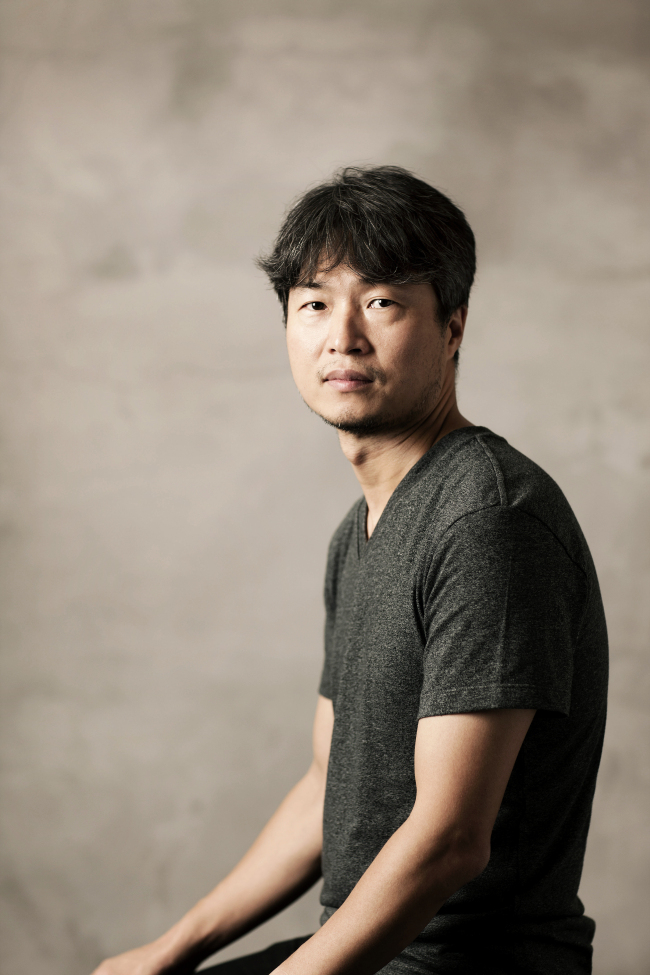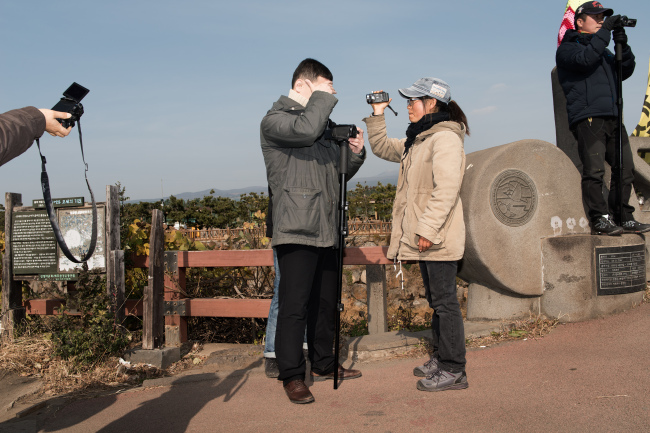[Herald Interview] Complexity of Korean society captured through a lens
Artist Noh Sun-tag seeksto explore the nature ofsocial conflicts, politicsand the division of Southand North Korea
By Lee Woo-youngPublished : Oct. 28, 2014 - 20:50
Artist Noh Sun-tag’s work resembles that of a photojournalist. He has taken pictures of tense and sometimes violent protests.
Most recently, he was on the site of protests in Miryang, South Gyeongsang Province, against the construction of a high-voltage power transmission tower there. Over the last decade, Noh has captured highly charged scenes including protests against U.S. troops and mass labor strikes.
“In the beginning, I visited those places out of pure curiosity to figure out something that I didn’t see on TV news. But later, I became interested in the nature of these situations,” said the 42-year-old in an interview with reporters at the Museum of Modern and Contemporary Art, Korea last month, after the museum announced him as the winner of its Artist of the Year award.
Most recently, he was on the site of protests in Miryang, South Gyeongsang Province, against the construction of a high-voltage power transmission tower there. Over the last decade, Noh has captured highly charged scenes including protests against U.S. troops and mass labor strikes.
“In the beginning, I visited those places out of pure curiosity to figure out something that I didn’t see on TV news. But later, I became interested in the nature of these situations,” said the 42-year-old in an interview with reporters at the Museum of Modern and Contemporary Art, Korea last month, after the museum announced him as the winner of its Artist of the Year award.

The award jury said that Noh’s work deals with social and political issues at such a deep level that it seems to touch on the nature of photography and society. His works were noted for delivering the high intensity of each protest scene with a touch of humor that turns the intensity upside down.
Noh, who started his photography career in journalism, began to notice aspects of protest scenes he couldn’t see in newspaper photos.
“The photos show how complex Korean society is. Some situations are almost like a black comedy,” he said.
What makes his works different from journalistic photos is the curiosity that the photos trigger in viewers.
In one of his works, a man stands face to face with a woman at a protest site, with the man covering his face and the woman holding her camera at him.

“It makes viewers wonder what’s going on. It almost looks like a theatrical scene. The man is a police officer and he was capturing the face of the woman who was there as one of the protesters for a record. She asked the policeman why he was photographing her face, and said she would capture his face too with her camera. He covered his face with his hand, saying I have the right not to be photographed as well,” Noh explained.
Noh captures the ironies of the authorities’ attempts to exercise power and control over the angry or confused public in the wake of national emergencies or protests.
His 2013 series “In Search of Lost Thermos Bottles” traces a comical episode in which the then-head of the ruling Grand National Party Ahn Sang-soo called a thermos a bombshell fired by North Korea at Yeongpyeongdo Island in 2010.
“The division of Korea into the North and the South is a serious issue here. But it sometimes produces silly and comical situations like this,” Noh said.
Korea’s national division has been a major subject of his works.
He made a calendar with some of his photos of milestone events in the tumultuous modern history of Korea, including the democracy movement in 1960, the military coup d’etat in 1961 and the Gwangju Democracy Uprising in 1980. Noh named it the “calendar of people of a divided nation.”
In these events, which were not directly related to North Korea, the South Korean government charged scores of democracy activists and protesters with serving the interests of North Korea, an enemy of South Korea. Some of them were given long prison sentence for violating the National Security Law, a product of the Korean division.
“It continues to this day,” said Noh.
Extreme conservatives often label people protesting for their labor rights or the right of residence “pro-North.”
“The label is put on those people whose life is not related to the North Korean issues, including the elderly protesting against the construction of the high-voltage power line in Miryang and the parents protesting to uncover the truth of the Sewol ferry sinking tragedy,” said Noh.
“Korean society needs an in-depth debate about such social issues which have nothing to do with North Korea. But somehow the ‘pro-North’ label wraps up the discussion really quickly.”
Referring to the incident in which Ahn called a thermos bottle a bombshell, he calls it a “symbolic example showing the politics of a divided nation operating and malfunctioning at the same time.”
“I have tried to dig into the nature of social conflicts and found the malfunction of society. I will continue to observe it through the eyes of an artist,” he said.
By Lee Woo-young (wylee@heraldcorp.com)








![[Kim Seong-kon] Democracy and the future of South Korea](http://res.heraldm.com/phpwas/restmb_idxmake.php?idx=644&simg=/content/image/2024/04/16/20240416050802_0.jpg&u=)







![[KH Explains] Hyundai's full hybrid edge to pay off amid slow transition to pure EVs](http://res.heraldm.com/phpwas/restmb_idxmake.php?idx=652&simg=/content/image/2024/04/18/20240418050645_0.jpg&u=20240418181020)

![[Today’s K-pop] Zico drops snippet of collaboration with Jennie](http://res.heraldm.com/phpwas/restmb_idxmake.php?idx=642&simg=/content/image/2024/04/18/20240418050702_0.jpg&u=)